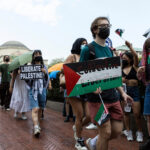Published May 1, 2003
Books & Culture
By Michael Cromartie
In 1984 the French scholar Gilles Kepel published a pathbreaking study of modern Islamist movements, issued the following year in a slightly updated edition in English translation as Muslim Extremism in Egypt: The Prophet and Pharaoh (Univ. of California Press). Kepel, who is professor of Middle East Studies at the Institute for Political Studies in Paris, has revisited the subject in his important book, Jihad: The Trail of Political Islam, published last year by Harvard University Press. Michael Cromartie spoke with Kepel in December.
Some commentators on your book suggested that you paint an overly optimistic picture of the future.
Many people do not really understand what I was saying. It’s not an issue of being optimistic or pessimistic; it’s more an issue of trying to be realistic about what is taking place in the Muslim world today.
So it’s more descriptive.
Yes. And it may be perceived as optimistic because, after 9/11, many commentators—who became instant experts on the issue—have described the Muslim world as irredeemably violent, characterized above all by a deep-seated animosity against the West.
We should not mistake the tree for the forest. Making such distinctions is particularly difficult now, but I have been doing that job for 25 years. I was probably the first scholar in the West to write a book on contemporary Islamist movements, Muslim Extremism in Egypt, which I wrote in the mid-1980s. Political Islam is nothing new to me. I’ve always tried to look at it in cold blood.
Today there are signs of increasing openness to democratization. But this is really the only alternative if the whole Muslim world is not to slide back to the Stone Age. They are lagging behind everywhere. They have not created anything in terms of the advancement of science. Their scientists are increasingly poor. There is no upward social mobility. What they have is oil and nothing else. And oil is unevenly distributed. This is the big challenge they are facing.
You say that political Islam has been “two-pronged” from the outset. On the one hand are the Khomeinists, who were behind the 1979 revolution in Iran. On the other hand are the Wahhabis, whose influence is strongest in Saudi Arabia. How are these two kinds of political Islam different?
Well, Khomeinism needed to mobilize the impoverished masses, in order to achieve the aim of toppling the Shah’s system. When Saddam Hussein attacked Iran, the year after the revolution, those impoverished masses were sent to their death in the Iraqi minefields. Much the same thing happened in the French Revolution with the sans-culottes. After the revolution, they were sent to Italy to pillage and loot so they would be estranged from the political center in France. But the Khomeinists had to mobilize the downtrodden masses to bring about revolution, and so from the outset their movement had a socially revolutionary parlance.
In contrast, the Wahhabis were never social revolutionaries. They were, and still are, social conservatives. Their understanding of religion favors the dominance of central Arabian Peninsula Bedouins, and has been used to legitimize their possession of the oil money from the Saudi royal family. To accomplish that, they needed two things. First, they needed to be in a very close alliance with the United States, a deal which was done when FDR met with Ibn Saud after the Yalta conference in February 1945. And, at the same time, they needed to buy peace with their local constituency. They used Islam as a means, if you will: by pretending to be exceedingly pious and uncompromising in religious matters, they deflected criticism for being stooges to the United States and for using the oil money disproportionately for themselves.
Wahhabi Islam was an ally of the West during the Cold War, against Soviet influence in the Middle East, particularly in Egypt, Syria, Iraq, and South Yemen—and ultimately in Afghanistan. After the success of the Iranian revolution in 1979, the Khomeinists hoped to unify the diverse Islamic movements under their control. In response, the United States encouraged the Wahhabi establishment as a counterforce within Islam that might attract young radicals, not to Iran, where they would be used against the West, but to jihad in Afghanistan, where they could be enrolled against the Soviet Union.
You describe a power struggle between these two versions of political Islam throughout the 1980s and 1990s.
Yes, and this has to be understood in the light of U.S. policy. Clearly, through the 1980s there was a strategy of containment, which was designed around Iran so that the Islamic revolution would not spread. Saddam Hussein—who then, we have to remember, was the darling of the West and the darling of conservative Arab states—attacked Iran with the West’s blessing on September 22, 1980. That led to an eight-year trench war, which was absolutely awful, between Iran and Iraq. And simultaneously, there was the jihad in Afghanistan, which was supposed to distract radical revolutionary Muslim youth from attacking the West.
From one point of view, the strategy worked spectacularly well. In 1988 Khomeini had, as he said himself, “to drink from the poisoned chalice,” i.e., he had to sign a cease-fire treaty with Saddam Hussein. And on February 15, 1989, Gorbachev decided to pull out of Afghanistan, which sounded the death knell for the Soviet empire. Everyone focuses on fall of the Berlin Wall, which took place the same year. But there would have been no bringing down of the Berlin Wall had there not been a Soviet pullout that signaled a clear military defeat of the seemingly invincible Red Army.
When I was kid in France, when I wouldn’t eat my soup or whatever, people told me, “You have to be good, otherwise the Soviets in 48 hours can reach you!” The Red Army was seen as a threat. They had been equipped with tanks that could roam all over the flat plains of Central Europe. But they proved inefficient on the very different terrain of Afghanistan. And the shoulder-launched Stinger missiles kept Russian planes out of the skies.
Afghanistan was crucial. I think that historians of the Cold War have downplayed it because they focus on Europe. But the test was Afghanistan. Afghanistan was the Vietnam of the Soviet Union. It was a Vietnam that led to the demise of the entire Soviet empire, which was not the case for the real Vietnam, from which the United States recovered even though it was weakened significantly.
In 1989, then, U.S. policymakers believed that this issue of radical Islam was under control. My contention would be—and I know this is difficult for an American audience to accept—that to a large extent, 9/11 was the “chickens coming home to roost.” That is, it was the outcome of this cheap war in Afghanistan. The United States thought the Afghan jihad was a bargain because no American kids died there; it was only those bearded guys who were freedom fighters, who had no mothers, who would not come to the mall and protest; no Vietnam War mothers. And it was a bargain because the cost of the war was $1.2 billion a year, half of which was covered by the Saudis and the Kuwaitis. Six hundred million dollars a year to topple the Soviet Union was peanuts.
But the war in Afghanistan proved to be a turning point for the Islamist movement. Those who had fought there believed that there was no time anymore for an alliance between the pious middle classes and the young urban revolutionaries. They argued that the Islamist movement should mimic the Afghan jihad experience, seeking to implement something similar in Egypt, in Bosnia, and so on, a sort of guerrilla warfare to seize power.
For their part, the pious middle classes were frightened out of the movement by the violence of the radical youth. Gradually, they sought a new type of alliance with the secular middle classes against authoritarian regimes. So on the one hand, we have bin Laden, who engaged in ultra-terrorism—terrorism as a means to mobilize people through spectacular violence that then is transmitted by the media. And on the other hand, there is the Turkish experiment. In the Justice and Development Party founded by Recep Tayyip Erdogan, you have a core group who in the old days were allied with the radicals, but who have now severed their ties with them, finding common cause with the secular middle classes on the basis of an anti-authoritarian program. The result is a hybrid party, led by former Islamists who now say their goal is democracy, getting into the European Union, and so on. They have to be taken at their word, and we’ll see what happens next. Will they continue to meld with the upwardly mobile secular middle classes, or will they be driven back toward radical violence?
We in the West should be very careful in our analysis. I do not believe that political Islam is a unified movement. On the contrary, it continues to be racked with internal strife and contradictions. We have to assess those contradictions very clearly if we want to understand what we are dealing with.
Does that make you optimistic about the decline of radical Islam?
It’s not the decline of radical Islam. It’s the decline of Islamism as a movement that was able to reconcile the deprived, radical youth and the middle classes. My contention is that the key group within this cluster was the pious middle classes. And they are now seeking alliances with secular middle classes, as in Turkey. Then the radicals are marginalized. That is why they engage in spectacular violence, in order to mobilize those around them. This is a very volatile situation, especially given the potential war on Iraq. Depending upon how the war is managed, those pious middle classes may revert to an alliance with the radicals—if, for instance, the war with Iraq is perceived as a war against Islam—or, on the contrary, they may cling to their newfound alliance with the secular middle classes.
And your prediction is?
I don’t know. I think it will largely depend on how the war is implemented.
Jihad: The Trail of Political Islam by Gilles Kepel, Anthony Roberts (Translator) Harvard University Press; (April 2002) 416 pages; 20.97, Hardcover
Source Notes
Copyright ? 2003 by the author or Christianity Today International/Books & Culture magazine.
Click here for reprint information on Books & Culture.
May/June 2003, Vol. 9, No. 3, Page 7








